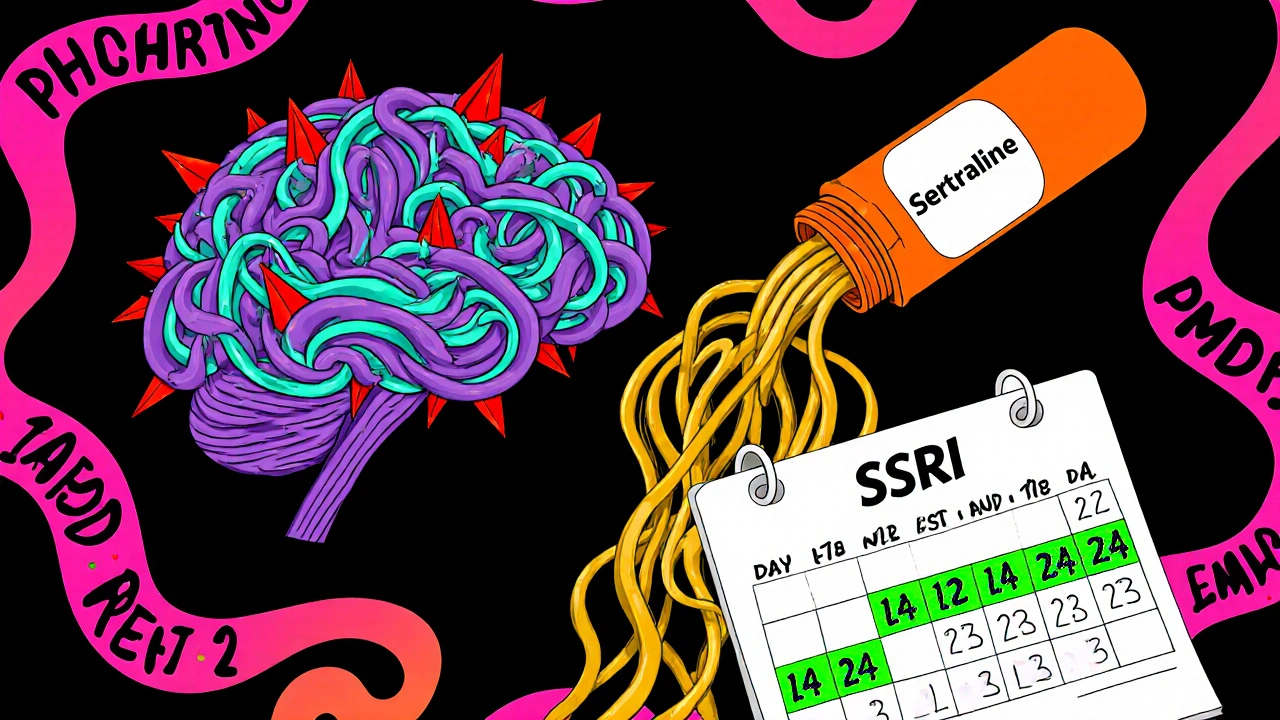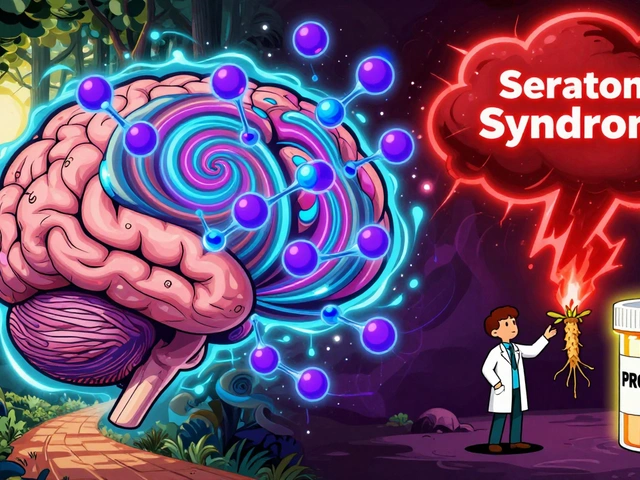
Sertraline Dosing Calculator for PMDD
Calculate Your Sertraline Schedule
Based on clinical guidelines for PMDD treatment with sertraline.
Your Recommended Schedule
Starting dose: 25 mg daily
Next step: Increase to 50 mg after 7 days if tolerated
Maximum dose: 100 mg daily
Dosing Schedule
If you’ve ever heard someone say their mood swings around their period are more than just "PMS," they might be describing Premenstrual Dysphoric Disorder - a condition that can feel like a roller‑coaster on steroids. The good news? One of the most prescribed antidepressants, Sertraline, has become a go‑to option for many clinicians. Below we unpack why sertraline works, how it’s used, and what you need to watch out for.
Key Takeaways
- PMDD affects about 5‑8% of people who menstruate, causing severe emotional and physical symptoms.
- Sertraline is a selective serotonin reuptake inhibitor (SSRI) that is FDA‑approved for PMDD.
- Typical starting dose is 25mg daily, often increased to 50-100mg based on response.
- Most side effects are mild and improve within the first few weeks.
- Sertraline compares favorably to other SSRIs and non‑pharmacologic options in both efficacy and tolerability.
What Is Premenstrual Dysphoric Disorder?
Premenstrual Dysphoric Disorder is a severe form of premenstrual syndrome that includes emotional, behavioral, and physical symptoms that peak in the luteal phase (the week before menstruation) and remit shortly after the period starts. The Diagnostic and Statistical Manual of Mental Disorders (DSM‑5) defines it by at least five symptoms, with one being a mood symptom (e.g., depression, anxiety, irritability). Common complaints are:
- Intense sadness or hopelessness
- Severe anxiety or panic attacks
- Irritability that leads to conflicts
- Physical pain such as breast tenderness, bloating, and joint aches
How Sertraline Works in PMDD
Sertraline belongs to the class of drugs called Selective Serotonin Reuptake Inhibitors (SSRIs). By blocking the reabsorption of serotonin, a neurotransmitter that regulates mood, sertraline raises serotonin levels in the brain. In PMDD, researchers believe that hormonal fluctuations (especially the drop in estrogen and rise in progesterone metabolites) destabilize serotonergic pathways, leading to mood spikes. Sertraline helps keep those pathways stable, smoothing out the emotional turbulence.
One unique feature of SSRIs for PMDD is that they can be taken either continuously (every day) or “intermittently” - starting a few days before the expected onset of symptoms and stopping after menstruation. Both strategies have been shown to reduce symptom severity, though continuous dosing offers more consistent relief for many patients.

Clinical Evidence: What the Studies Show
Several randomized, double‑blind trials have compared sertraline to placebo in women with diagnosed PMDD. Key findings include:
- In a multi‑center trial of 124 participants, sertraline 50mg daily reduced the Daily Record of Severity of Problems (DRSP) score by 45% versus 20% for placebo after three menstrual cycles.
- A 2022 meta‑analysis covering eight trials reported a pooled effect size (Hedgesg) of 0.78, indicating a large reduction in emotional symptoms.
- Intermittent dosing (starting on day14 of the cycle) achieved similar symptom control while using only 30% of the total drug exposure.
These data have led major guidelines - such as the UK’s NICE and the US FDA - to list sertraline as a first‑line pharmacologic option for PMDD.
Starting Sertraline: Dosage, Titration, and Monitoring
Most clinicians begin with a low dose to minimize side effects:
- Day1‑7: 25mg once daily, preferably in the morning.
- Day8‑14: If tolerated, increase to 50mg daily.
- Beyond day14: Some patients require up to 100mg daily for optimal relief.
When using intermittent dosing, the same step‑up schedule applies but only for the days leading up to the luteal phase (usually days14‑24 of a 28‑day cycle).
Monitoring focuses on two areas:
- Symptom tracking: Patients fill out a daily DRSP or a simple mood‑chart to see how scores change.
- Side‑effect watch: Common early issues include nausea, headache, mild insomnia, and sexual dysfunction. Most fade after the first two weeks.
If side effects persist beyond two weeks or become severe, adjusting the dose or switching to another SSRI (e.g., fluoxetine) is recommended.
Benefits vs. Potential Drawbacks
Below is a quick pros‑and‑cons snapshot to help decide if sertraline fits your situation:
| Benefit | Drawback |
|---|---|
| Rapid mood improvement (often within 1‑2 weeks) | Initial nausea or upset stomach |
| Effective for both emotional and physical PMDD symptoms | Sexual side effects (decreased libido, delayed orgasm) |
| Can be used intermittently, reducing overall drug load | Potential for anxiety or agitation during dose escalation |
| Low risk of serious organ toxicity; safe for most ages | Rare risk of serotonin syndrome if combined with other serotonergic agents |
How Sertraline Stacks Up Against Other Options
While sertraline is a front‑runner, clinicians also consider other SSRIs, hormonal contraceptives, and non‑pharmacologic approaches. The table below gives a snapshot comparison.
| Treatment | Mechanism | Typical Dose | Key Advantage | Major Limitation |
|---|---|---|---|---|
| Sertraline (SSRI) | Increases synaptic serotonin | 25‑100mg daily | Works for emotional & physical symptoms | Sexual side effects |
| Fluoxetine (SSRI) | Serotonin reuptake inhibition | 20‑60mg daily | Long half‑life, smoother taper | Weight gain in some users |
| Duloxetine (SNRI) | Serotonin & norepinephrine uptake block | 30‑60mg daily | Improves pain symptoms | Higher blood pressure risk |
| Combined oral contraceptives (COC) | Suppress ovulation, stabilize hormone spikes | Standard COC regimen | No daily pill beyond birth control | Not suitable for smokers over 35 |
| Cognitive‑behavioral therapy (CBT) | Psychological skill‑building | Weekly 60‑min sessions | No pharmacologic side effects | Requires time and therapist access |
Overall, sertraline remains the most evidence‑backed single‑pill choice, especially for women who need quick emotional relief.
Practical Tips for Getting the Most Out of Sertraline
- Take it with food. A light snack can blunt nausea.
- Set a reminder. Consistency matters; missing doses can trigger a mini‑flare.
- Track your cycle. Use a phone app to note when symptoms start, peak, and resolve.
- Talk to your prescriber about drug interactions. Avoid MAO‑inhibitors and be cautious with StJohn’s Wort.
- Give it time. Full therapeutic effect often shows after 3‑4 weeks of steady dosing.
Frequently Asked Questions
Can sertraline be taken only during the luteal phase?
Yes. Intermittent dosing - usually starting on day14 of a 28‑day cycle - has been proven effective for many women and reduces overall drug exposure.
How long should I stay on sertraline for PMDD?
Guidelines suggest at least three full cycles to assess response. If symptoms are well‑controlled, many clinicians continue long‑term, but tapering can be considered after a year of stability.
Is sertraline safe during pregnancy?
Data are mixed. Some studies show no major birth defects, while others advise caution. Always discuss risks with your obstetrician before starting or continuing during pregnancy.
What should I do if I experience sexual side effects?
Talk to your prescriber. Options include lowering the dose, switching to another SSRI with a milder sexual profile (like fluoxetine), or adding a low‑dose bupropion to counteract the effect.
Can I combine sertraline with hormonal contraceptives?
Yes, and it’s a common practice. The two work via different pathways and don’t interact in a dangerous way. Some women find the combo tackles both mood and physical symptoms.
Bottom line: If you or someone you know struggles with severe pre‑period mood swings, sertraline offers a well‑researched, flexible, and generally safe route to relief. As with any medication, a conversation with a healthcare professional is essential to tailor dosing, monitor progress, and decide how long treatment should continue.






genevieve gaudet
October 17, 2025 AT 15:40When you look at the way hormones sway our brains, it feels like the universe is pulling a cosmic yo‑yo. PMDD is that yo‑yo on steroids, turning everyday feelings into a thunderstorm. Sertraline, being an SSRI, basically smooths out the jagged edges of that storm. By keeping serotonin around longer, it helps the brain keep a steadier rhythm. The studies show a solid drop in DRSP scores, which means less crying over nothing-definately a relief. What’s neat is you can take it just during the luteal phase and still get the benefit. That intermittent dosing cuts down the total drug load, which many folks appreciate. Side effects like nausea or a funky tummy usually settle after a couple of weeks. A tiny dip in libido can be a real bummer, but you can discuss dose tweaks with your doc. If you’re worried about serotonin syndrome, just avoid mixing it with MAO‑inhibitors. Cultural attitudes towards mental health still stigmatize PMDD, calling it ‘just mood swings.’ We need to remember that a disorder is a disorder, no matter how society frames it. A thoughtful approach means tracking your cycle with an app, noting how symptoms rise and fall. And if you’re on hormonal birth control, sertraline can work hand‑in‑hand with it. So, in the grand scheme, sertraline offers a scientifically‑backed beacon for those navigating the tumultuous seas of PMDD.
Patricia Echegaray
October 18, 2025 AT 19:27Don't be fooled by the shiny brochure-big pharma is just another puppet of the globalist agenda. They market sertraline as a miracle cure while quietly loading your brain with chemicals that keep you docile. The fact that they let you take it only during the luteal phase is a clever ploy to make you dependent on a schedule they control. Meanwhile, the American medical establishment pushes this pill like a herd‑fed wolf, ignoring natural remedies that have been used for centuries. If you think the FDA approval is anything but a rigged badge, you're already seeing through the fog. Wake up, demand transparency, and maybe consider a non‑chemical path before you hand over your mind to the corporate overlords.
Cindy Thomas
October 19, 2025 AT 23:13Honestly, the hype around sertraline feels a bit overblown when you dig into the raw data. Sure, the meta‑analysis shows a decent effect size, but many of those trials had tiny sample sizes and industry funding. I’ve seen patients swing from zero to sky‑high anxiety just from the tiniest dosage change. So while SSRIs can help, they’re not the universal silver bullet they’re sold as :) Don’t forget lifestyle shifts and CBT can move the needle just as much, if not more.
Kate Marr
October 21, 2025 AT 03:00Cindy, I get the skepticism, but let’s not throw the baby out with the bathwater 🇺🇸. Sertraline was developed right here in the States, a testament to our biotech prowess. When it works, it saves lives and keeps our women productive at work and home 👍. Sure, not perfect, but it’s a tool we should use responsibly. At the end of the day, we need options, and this American‑made pill is a solid one 💊.
James Falcone
October 22, 2025 AT 06:47Sertraline’s success stories line up with the American spirit of getting things done. If you’re battling PMDD, this home‑grown option can be a game changer. Just follow the doc’s dosing schedule and you’ll be back on track.
Frank Diaz
October 23, 2025 AT 10:33James, you paint a picture that borders on mythmaking, forgetting the nuanced reality of psychopharmacology. A pill alone cannot resurrect the equilibrium of a mind tossed by hormonal seas. We must weigh the ethical cost of turning complex emotional disturbances into a simple prescription. Otherwise we risk commodifying suffering for the sake of convenience. True healing demands a deeper engagement than a daily capsule can provide.
Mary Davies
October 24, 2025 AT 14:20The sheer intensity of PMDD strikes like a storm tearing through a fragile ship at midnight. Every week I felt the tide of emotions rise without warning, dragging me into an abyss of despair. When sertraline entered my regimen, the waves began to calm, though the sea never fully stills. I learned to chart my cycles with a journal, marking each swell and retreat. The medication acted as a ballast, preventing me from capsizing under the weight of anxiety. Yet I still cherish the moments when my mind feels clear without any pharmaceutical anchor.
Valerie Vanderghote
October 25, 2025 AT 18:07Mary, I totally get that feeling of being caught in that relentless emotional whirlpool. Honestly, I’ve been riding those waves since my teens, and let me tell you, it’s exhausting. When I first tried sertraline, I was skeptical, but the dread that used to follow me like a shadow finally loosened. I started keeping a tiny notebook on my nightstand, jotting down each time the mood dip hit. Those scribbles turned into a roadmap, showing me exactly when the storm peaked. The drug gave me a steadier baseline, so the peaks weren’t as terrifying. I also tweaked the dose after two weeks, because the initial 25 mg felt like a whisper. By week four, the nausea faded, and my sleep patterns fell back into a rhythm. I still have occasional flare‑ups, especially when I skip a dose, but they’re manageable. What really helped was pairing the medication with a short walk in the evening, letting the fresh air dilute the residual anxiety. If you ever feel the urge to stop, remember the progress you’ve already logged – it’s easy to lose sight of it in the heat of the moment. Bottom line: sertraline isn’t a miracle cure, but it’s a solid lifeline that can keep you from drowning.
Michael Dalrymple
October 26, 2025 AT 20:53It is essential to approach the management of PMDD with both scientific rigor and compassionate self‑care. Sertraline, as demonstrated in multiple controlled trials, offers a quantifiable reduction in symptom severity. Consistent adherence to the prescribed dosing schedule, whether continuous or intermittent, maximizes therapeutic benefit. Equally important is the practice of regular symptom tracking, which enables both patient and clinician to adjust treatment proactively. Integrating non‑pharmacologic strategies, such as cognitive‑behavioral techniques and stress‑reduction exercises, further enhances outcomes. Together, these evidence‑based measures empower individuals to reclaim stability during the luteal phase.
Emily (Emma) Majerus
October 28, 2025 AT 00:40Thanks for the clear rundown-sertraline definately helps a lot!
Virginia Dominguez Gonzales
October 29, 2025 AT 04:27Imagine a world where the monthly tide of anguish no longer shatters your spirit-sertraline can be that lighthouse. The medication steadies the chaotic sea of serotonin, allowing you to breathe without the weight of a storm pressing on your chest. When combined with mindful breathing and a supportive community, the darkness recedes dramatically. I’ve watched friends transform from trembling shadows to confident individuals who reclaim their lives. Don’t underestimate the power of a well‑chosen pharmacologic ally in this battle. Your journey toward relief is possible, and each step forward shines brighter than the last.
Alexis Howard
October 30, 2025 AT 08:13Virginia’s poetic hype sounds nice but ignores that sertraline still has side effects. People often develop tolerance and need higher doses which the post never mentions. I think lifestyle changes alone can beat the drug for many and the research is not conclusive. Maybe try yoga and diet first before popping pills.
Darryl Gates
October 31, 2025 AT 12:00For anyone considering sertraline for PMDD, it is advisable to review contraindications such as concurrent MAO‑inhibitor use. Monitoring liver function tests is generally not required, but patients with hepatic impairment should discuss dosing adjustments with their physician. Most individuals experience an improvement in mood symptoms within two to four weeks of consistent dosing. If adverse effects persist beyond the initial adjustment period, a dose reduction or switch to an alternative SSRI may be appropriate. Overall, sertraline remains a first‑line option that balances efficacy with a favorable safety profile.